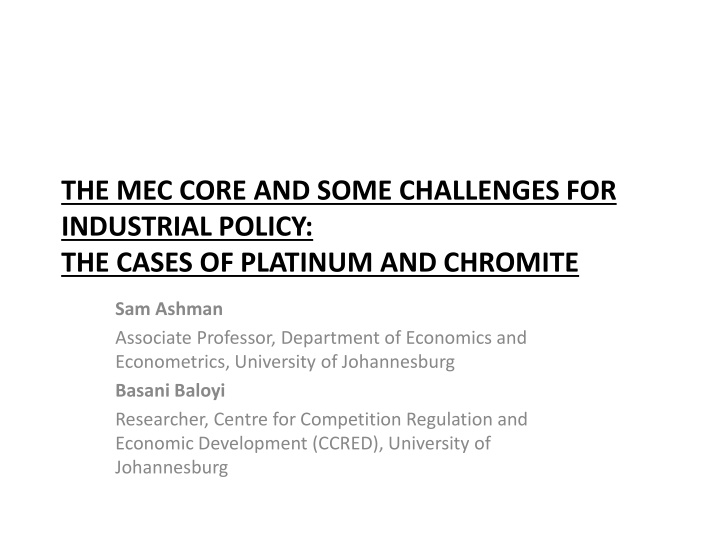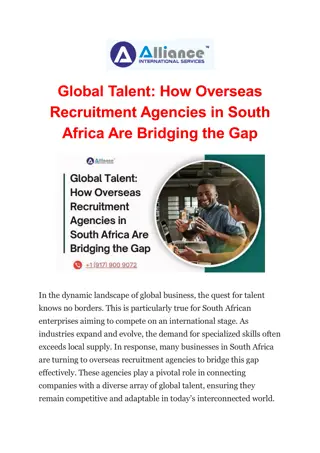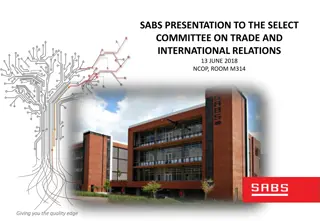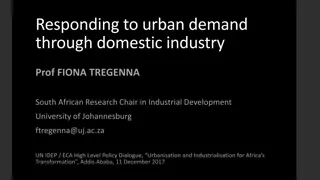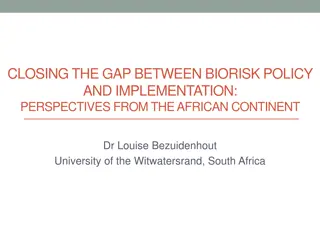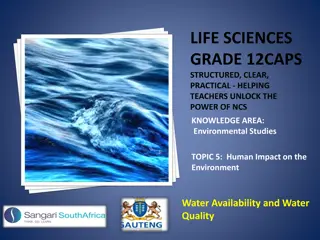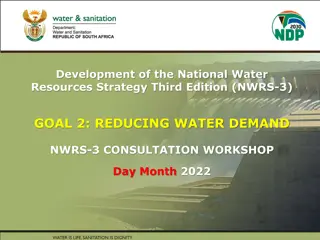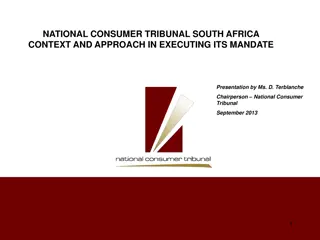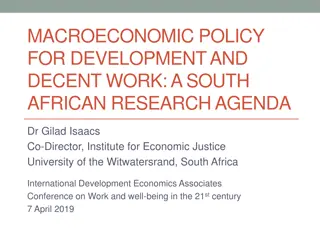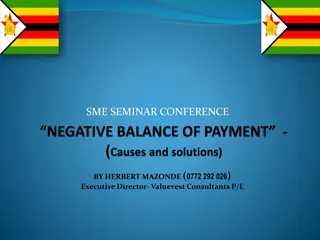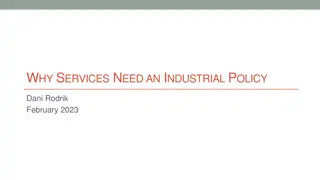Challenges and Opportunities in Industrial Policy: South Africa's Platinum and Chromite Sectors
Analyzing the gap between mineral resources and domestic beneficiation in South Africa, this study delves into the challenges faced by the country's industrial policy, particularly in the platinum and chromite sectors. It discusses strategies to create more inclusive growth paths and overcome obstacles hindering linkages and sustainable development, within the dynamic context of the Minerals-Energy Complex (MEC) core. The paper emphasizes the historical, structural, and empirical aspects of industrial development, highlighting the need for a nuanced approach rooted in economic and political analyses.
Download Presentation

Please find below an Image/Link to download the presentation.
The content on the website is provided AS IS for your information and personal use only. It may not be sold, licensed, or shared on other websites without obtaining consent from the author.If you encounter any issues during the download, it is possible that the publisher has removed the file from their server.
You are allowed to download the files provided on this website for personal or commercial use, subject to the condition that they are used lawfully. All files are the property of their respective owners.
The content on the website is provided AS IS for your information and personal use only. It may not be sold, licensed, or shared on other websites without obtaining consent from the author.
E N D
Presentation Transcript
THE MEC CORE AND SOME CHALLENGES FOR INDUSTRIAL POLICY: THE CASES OF PLATINUM AND CHROMITE Sam Ashman Associate Professor, Department of Economics and Econometrics, University of Johannesburg Basani Baloyi Researcher, Centre for Competition Regulation and Economic Development (CCRED), University of Johannesburg
THE PROBLEM The gap between the scale of mineral resources and extent of domestic beneficiation - an old problem Dominance of exports my minerals - gold, PGMs, iron ore, coal, motor vehicles, iron and steel, non-ferrous metals = approximately 60% of SA exports How to build linkages and create more broad based and self-sustaining growth path in this context? The gap is recognised in policy debate, but how is it to be overcome, what are the obstacles? Industrial Policy as dynamic terrain of conflict Paper analyses two minerals central to South Africa s evolving Minerals-Energy Complex (MEC) (Fine and Rustomjee 1996) where South Africa dominates global reserves and production
OVERVIEW The MEC core and its implications Platinum and Chrome Rise of platinum in the MEC core Chrome ,ferrochrome and de-industrialisation in the core? Crises and response .. ..Yet non-implementation of policy Where is progress on SIMS report recommendations? (ANC policy) Where export tax for chrome? (ANC policy)
THE MEC CORE Industrial policy needs to be rooted in a dynamic, historical and structural context The MEC is an analysis of industrial development simultaneously focussing on different dimensions of interdependencies between fractions of capital, industrial sectors and the state that involves, but is not limited to - Economic and political analysis through the emphasis on evolving relations and conflicts and how these are reflected in patterns of accumulation and economic and social reproduction Empirical identification based upon material linkages (input-output) between sectors that reveal industrial sectors with strong linkages with each other and relatively weaker linkages with sectors outside of the MEC core (Kaldor/Hirschman) The development of the MEC core has come about through the dialectic between industrial structure and policy. Industrial policy under apartheid supported development of industries with strong forward and backward linkages to extractive industries. Self-reinforcing core that grows in relative isolation (and at the expense of) economic activities outside of the core
THE MEC CORE (2) Late 1980s: Economic and political disjuncture between English and Afrikaner capital eroded South African economy controlled by 6 diversified conglomerates Trade and financial liberalization and privatisation adopted in closing years of apartheid driven by: capital s fear of political transformation potential gains from global reintegration Macro policy GEAR onwards serves particular interests Offshore listing and managed capital flight seeking to benefit from financialised accumulation Washington consensus conception of industrial policy: Narrowly focussed on stable macroeconomic environment Industrial intervention scattered and small scale (supply side oriented) Any gains in terms of industrial diversification made in the 1970s and 1980s quickly unwound with import competition and de-conglomeration Evidence of de-industrialization in the MEC core? Chrome/ferrochrome suggests
THE CHANGING MEC CORE Since early 1990s platinum has been the fastest growing sub-sector within mining South Africa largest global producer, and has the largest global reserves, of both platinum and Platinum Group Metals (PGMs) and chromite Deposits of both concentrated in the Bushveld Igneous Complex (BIC), which straddles the North West, Limpopo, Mpumalanga and Gauteng provinces. BIC area has been the fastest-growing South African region Zimbabwe has the second largest deposits of platinum in the world, SA producers expanding regionally Platinum has been mined in South Africa since the 1920s, global demand for platinum has increased due to catalytic converters in vehicles (especially Europe) luxury jewellery (increasingly from China and to a lesser extent India) industrial uses for platinum with long term future potential such as fuel cell technology (Butler 2012) Investment Commodity Crisis in the sector following the global economic crisis, falling demand particularly for European catalytic converters, growing labour militancy Close connections between platinum and chrome producers, with the latter mineral mined as a by- product of the former this generates questions about the control of the chrome resource
CONCENTRATED OWNERSHIP AND CONTROL AND INTERCONNECTIONS Anglo American Platinum Corporation: 80% owned by Anglo-American Listed in London after Anglo Unbundled in 1995 Close and important relationship with Johnson Matthey (major European manufacture of platinum across the board) Impala Platinum Holdings Ltd Listed in London after unbundled from Gencor in 1997; 73% stake in Marula Platinum; 45% stake in Two Rivers Platinum (both in Limpopo) 87% stake in Zimplats, Zimbabwe and 50% stake in Mimosa Platinum (mine and refinery) in Zimbabwe, joint venture with Aquarius Platinum Royal Bafokeng important shareholder Lonmin unbundled from Lonhro in 1998/9 listed in London focus on PGMs (Eastern and Western), sold off coal (to Glencore), bought into platinum in Australia Created Incwala resources in 2003 to meet demands of Mining Charter Anglo-Swiss multinational Xstrata has a 25% stake in Lonmin (biggest shareholder), Xstrata one of South Africa s biggest coal producers, important supplier to Eskom Xstrata merged with Glencore and is now 4thbiggest mining company globally and biggest commodities trader globally Glencore 21% of chrome and ferrochrome market in SA
PLATINUMS DOMINANCE Goldman Sachs 20 Year Review of Freedom
GLOBAL DEMAND BY REGION 2013 2000 1500 1000 Europe 000 oz Japan North America 500 China ROW 0 -500
CONTRIBUTION TO EMPLOYMENT Source: South African Minerals Industry (2011)
CONTRIBUTION OF GOLD AND PGMs TO EXPORTS
LOCAL SALES AND EXPORT SALES Zinc Iron ore Manganese Lead Nickel PGMs Local sales Gold Export sales Diamonds Chrome Copper Cobalt Coal 0 20 40 60 80 100 120 %
WHERE DO LOCAL SALES FOR PLATINUM GO? IS THE GLASS HALF EMPTY OR HALF FULL? Need more thorough assessment of MIDP this paper is not, but there are important limitations to growth Majority of large components firms are foreign owned (all assemblers are foreign owned) MIDP favours exports, automotive exports now ahead of components exports but they are closely connected - lead firms in the automotive chain control global assembly operations and have linked supplier companies, they can rapidly increase exports from their own South African operations or from South African based suppliers to their international operations. (essentially a peripheral part of MNC operations) Export platform not more. Local assemblers in conjunction with their multinational parents developed large component export businesses, which did not contribute to the more integrated development of the automotive industry Note: C/C manufacture capital intensive Employment peaked in 2007 at 82,000 jobs in component manufacturing; today 70,000 (NAAMSA), 5,000 only directly in C/C manufacture Small domestic market - need more focus on domestic demand (integrated public transport system?) and regional demand to realise potential linkages C/C backward linkages can be maximised as production uses platinum and chrome and stainless steel Catalytic converter manufacture expanded rapidly under MIDP (succeed by APDP) By 2005 14% of world supply 44% of component exports from SA were C/C in 2012 (AIEC)
CHROME, FERROCHROME AND STAINLESS STEEL The largest single user of chrome ore is the metallurgical ferrochrome industry, and most of its demand (90 percent) is for the production of stainless steel. South Africa once the largest user of chrome ore and producer of ferrochrome in the world, China now leading global producer of ferrochrome and of stainless steel Consequence of disruptions in South Africa s supply of ferrochrome to China caused by South Africa s electricity crisis South Africa overtook India as the leading chromite supplier to China in 2007 after India implemented an export tax on chromite (Merafe 2012) Growth in China s ferrochrome industry made possible by access to South Africa s chromite reserves, which previously were held captive by the ferrochrome industry within South Africa In response, South Africa s ferrochrome producers have lobbied government for an export tax on the country s chrome ore reserves in order to secure access to the reserves ANC policy is to adopt export tax Not implemented - at least partly due to the resistance of the powerful major platinum producers who increasingly mine chrome as a by-product of platinum, and who would lose this cross-subsidy for the sector Platinum influence not just in platinum value chain, discussion to follow later
CHROME RESERVES AND PRODUCTION Global Chrome Reserves by Country Chrome Producers by Country Other 0.4 1.10.7 Zimbabwe Turkey 3.8 8.7 S.A. Brazil Albania Finland India 2011 Kazakhstan Zimbabwe 2002 Iran South Africa India Kazakhstand Finland 87.8 China Brazil 0.0 10.0 20.0 30.0 40.0 50.0
GROWTH IN SAS CHROME EXPORTS (2002-2011) MEETS SLUMP IN SA S FERROCHROME PRODUCTION (2002-2011) Ferrochrome Producers by Country Chrome Exports by Country Other Other Zimbabwe Zimbabwe Turkey Turkey S.A. Sweden Albania SA 2011 2011 Kazakhstan Russia 2002 2002 Iran Kazakhstan India India Finland Finland China China Brazil Brazil 0 10 20 30 40 50 0.0 10.0 20.0 30.0 40.0 50.0
SAS CHROME FACILITATES GROWTH IN CHINAS CHROME VALUE CHAIN 2002? 2011 ? China? 75%? ? ? ? ? ? ? ? ? ? ? Japan? 1%? ? US? 3%? ? ? ? ? ? ? ? ? ? ? ? ? ? ? ? ? ? ? ? UK? 1%? ? Netherlands? 3%? ? ? Italy? 1%? ? Germany? 2%? ? ? ? ? ? ? ? ? Argentina? 1%? ? Turkey? 2%? ? S.? Korea? 2%? ? ? 3414? (88%)? Stainless? steel? 42%? US? 15%? ? ? ? ? ? ? ? ? ? ? ? ? ? ? ? ? ? ? ? ? ? China? 4%? ? Netherlands? 14%? ? ? ? ? S.Korea? 4%? ? ? Japan? 13%? ? ? ? ? ? ? ? ? ? ? ? ? ? ? ? ? Italy? 4%? ? UK? 10%? ? Turkey? 7%? Stainless? steel? 6%? 651? (10.9%)? ? 2063? (20%)? ? Argentina? 6%? ? ? ? Chrome? 10824? kt? ? Chrome? 6436? kt? 2190? (91%)? Ferrochrome? 3422? kt? ? ? Stainless? steel? Stainless? steel? Ferrochrome? 2351? kt? 4770? (88%)? ? ? 196.2? (8%)? 7254.9? (78%)? 407.68? (11%)? ? ?
THE RISE AND FALL OF FERROCHROME Struggling Present: 2000- present Dismemberment in Ferrochrome industry captive market on chrome (32 % of cost) MPRDA 2004 facilitates new entry of non-integrated miners Technology improvements allow increasing usage of low grade platinum controlled UG seams while the Ferrochrome higher grade LG and MG seams deplete Electricity (18 % of cost) crisis deepens the crisis Giant Past: 1960-2000 West dominates ferrochrome production through the South (SA and Zim) chrome feed SA chrome value chain born and later dominates due to: MEC state-capital relations: IDC, subsidised electricity, Technological improvements: improve recovery of lower grade chrome making it possible for Western plants to relocate closer to source Private mining rights: captive chrome market and facilitate vertical integration structure key source of competitiveness
CAPTIVE MARKET FOR CHROME IS CRITICAL TO COMPETITIVE FERROCHROME PRODUCTION Major Ferrochrome Producers Costs Typical Smelters Costs
FERROCHROME INDUSTRY RESPONSE TO CRISIS Response strategies facilitating deindustrialisation in ferrochrome: closing plants, converting unprofitable furnace to manganese, Response strategies to improve efficiencies: investing in energy efficient technology, cost reductions, eskom s electricity buy back programme Lobbying for an export tax as an interim strategy while they restructure business
PLATINUM - POLICY 1 MIGDETT process NUM, Solidarity, Chamber of Mines, United Association of South Africa, DMR (Min Shabangu) 2008 in response to SA not capturing gains of commodity boom MIGDETT produces Strategy for Sustainable Growth and Meaningful Transformation 2010 for developing mining industry The strategy includes beneficiation but no instruments specified SIMS (2012) report (commissioned 2010) in response to nationalisation debate for minerals as a whole Crisis platinum grows following the global economic crisis, falling demand for platinum for c/c esp Europe MIGDETT for Platinum est early 2012 Min Shabangu orders the Platinum Task Team to develop a rescue plan with sector wide interventions Marikana massacre Aug 2012 during strike over pay highlighted range of economic and social questions unplanned growth in Rustenburg region
FERROCHROME POLICY 1 2008/9 ferrochrome approaches DMR over the crisis 2011 export taxes feature in beneficiation strategy of DMR No task team established over the 4 years until ferrochrome complains that platinum has its own task team Ferrochrome task team established Aug 2012 Task team includes: Ferrochrome Producers, UG2 Platinum Producers, Chrome Miners, and unintegrated ferrochrome producers, No union representation NUMSA major union in the sector known for its support for export taxes is not informed of process Platinum and Ferrochrome producers complain there is no rescue plan and that the task team is an information sharing platform only Even by the Min Shabangu s admission Ferrochrome producers have been leading the way for a solution to crisis
PLATINUM POLICY 2 - SIMS REPORT Fiscal Linkages, Backward Linkages, Forward Linkages, Knowledge Linkages, Spatial Linkages Greater redistribution of resource rents (the difference between the price at which a resource can be sold and its extraction costs, including normal returns) resource rent tax State minerals company Greater co-ordination dti and DMR, merger to super ministry Amend MPRDA to maximise developmental impacts, and to cater for strategic minerals such that it would permit concessions/licenses to have sales/pricing and other conditionality; and, for unexploited deposits, give first option for developing them to the state Lack of debate Lack of implementation why? Chrome/ferrochrome helps illuminate this
FERROCHROME POLICY 2: THE EXPORT TAX DEBATE AND PLATINUM S POWER Platinum Producers Position Export tax will result in retaliation from other producers Major source of crisis is electricity crisis therefore solution should be found there Against free trade principle and sets a precedent for export taxes in other commodities including PGMs Investor confidence and jobs will fall as it is used as a cushion against platinum's pressures Position supported by National Treasury Ferrochrome Producers Response SA Ferrochrome used dominance in the past to control price of chrome and platinum by shutting down production Export tax can be a temporary measure while the business restructures its energy technology Jobs will not fall in platinum as chrome is mined as a by product and is a small source of revenue
CONCLUSIONS MEC Core Pattern persists in platinum & chrome Evidence of persistance exports to European Multinational producers with catalytic manufacture for export by many of the same multinationals with little development of an integrated auto sector maximise domestic linkages Evidence of de-industrialisation in chrome value chain as a result electricity crisis and China Export tax could help in restructuring the power of platinum has shaped the policy process against such a possibility Lack of export tax on chrome negative impact on other sectors Will the policy recommendations of SIMs for platinum be pursued? The evidence thus far shows no, based on platinum s power and its sentiment towards beneficiation as demostrated by the export tax debate
